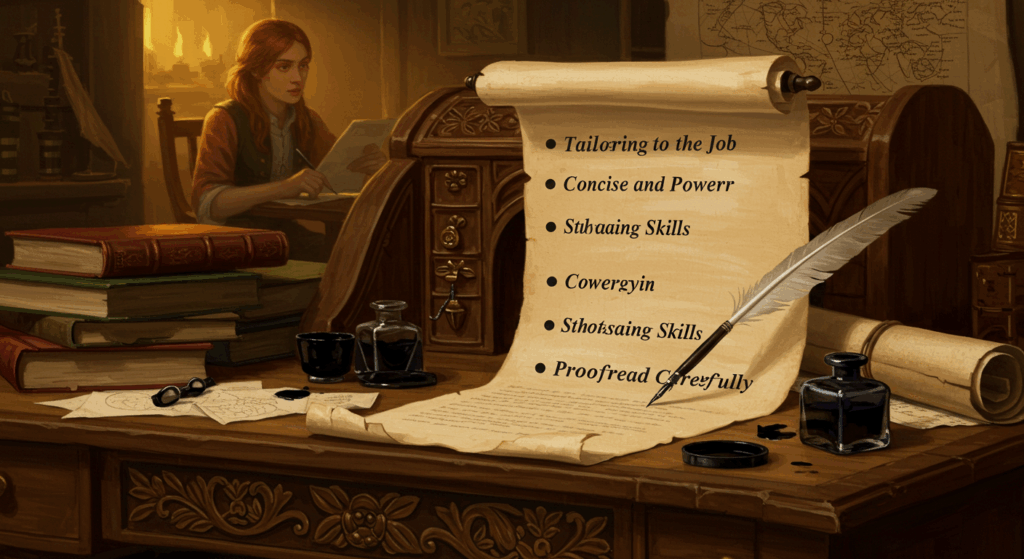A quick introduction (and why this matters more than you think)
Writing a cover letter feels a little like sending a flirty DM to someone you actually like. You’re trying to be cool, specific, a tad charming, and not too long. You also don’t want to sound like a robot or like you copied a template from page 1 of Google, because hiring managers can sniff that from a mile away (they have superpowers, apparently).
But ngl, a good cover letter can be the tiny hinge that swings a very big door. It adds contect your resume can’t, it shows you can write (hi, basic adulting), and it demonstrates that you get the role and the company. This article is your friendly guide to crafting a cover letter that’s clear, human, and actually fun to read. We’ll walk through the introduction, the format, and tons of examples so you can tweak and ship yours fast.
Also, slight promise: I’ll keep it conversational (like we’re sharing a dirty chai and you’re low-key venting about job hunting) and I’ll toss in a few small quirks because, you know, perfection is a little sus.
What a cover letter actually is (mini introduction)
A cover letter is a short note that answers three core questions:
- Why them?
- Why you?
- What happens next?
That’s it. It’s not an autobiography or a copy-paste of your resume. It’s a story—quick intro, proof you can do the work, and a warm close with a call-to-action. Think of it like a movie trailer: tease the best scenes, don’t spoil the plot.
When you really should write one (and when you can skip)
- Definitely write one when the posting asks for it, when the company values communication, when you’re changing careers, or when you’ve got a fun story—like you built a mini tool that solves the exact problem they have.
- You can sometimes skip for super transactional, high-volume apps where there’s no upload field (looking at you, some gig platforms). But if there’s a text box? Pop in a concise version.
- Email-only application? The email body is your cover letter. Keep it short but structured.
The mindset shift that fixes most cover letters
Imagine your reader: they opened 117 resumes today and 36 cover letters. They want clarity, a tiny bit of personality, and proof you did your homework. So your tone should be: friendly, direct, and confident—but not try-hard. We’re going for “I’m the grown-up you want in this role,” not “Pick me, love me, please.”
A good introduction grabs attention with something relevant to them: a recent launch, a metric from their careers page, a value you genuinely share, or a quick story from your work that mirrors their needs.
Before you write: the 10-minute research sprint
Open three tabs:
- The job description. Highlight the top 5 responsibilities + repeated keywords.
- The company site or blog. Grab one concrete detail: a product, user stat, value, or case study.
- LinkedIn or Glassdoor. Skim recent posts or culture notes for a vibe check.
Now jot a one-sentence thesis:
“I help [type of company] achieve [result] by doing [skills], and here’s proof that maps to your needs.”
This thesis secretly becomes your introduction and your north star while writing.
The cover letter format that just works (and won’t make you cry)
Let’s keep the format clean. Think one page max (≈ 250–400 words). Use a modern, readable font. Save as PDF unless the posting says otherwise. Here’s a simple structure:
- Header: Your info + date + their info (if you’re attaching a PDF).
- Greeting: “Hi [Hiring Manager’s Name],” is perfect.
- Opening paragraph (introduction): The hook. Why them + quick why you.
- Middle paragraph(s): 1–2 focused stories with metrics or outcomes (the receipts).
- Closing: Align your impact with their goal + invite next steps.
- Signature: Your name + contact + portfolio links.
If you’re pasting into an online form, you can drop the formal header. The format adapts—content stays.
Anatomy of a compelling introduction (hook without cringe)
Your first 2–3 sentences should do three things fast:
- Show you know the company (a tiny, specific detail).
- Position your value in their language.
- Tease a result you’ve achieved that connects to their needs.
Mini examples of intros:
- “When I saw you’re expanding your B2B product to mid-market teams, I thought about how we 3×’d activation at my last role by rebuilding the onboarding flow. I’d love to help [Company] do the same—faster.”
- “I’ve followed your push into climate tech since your 2023 report (obsessed with the emissions calculator). As a PM who’s shipped two data tools for non-technical users, I think I can help your next release land smoothly.”
- “You want a social lead who can grow followers and link clicks. Last quarter, my test series added 18% CTR with almost no extra budget. Let’s do that at [Company].”
Notice how these introduction examples name a detail (expansion, report, CTR) and tie it to relevant work.
The middle: stories with proof (aka the receipts)
Pick 1–2 stories that map to the job description. For each, use a micro-structure:
- Context: What was the situation?
- Action: What did you actually do? (Use verbs: led, built, designed, shipped, launched, analyzed.)
- Outcome: Numbers if you’ve got ’em. If not, impact (fewer bugs, faster onboarding, happier clients).
Short example:
At [Previous Company], our churn spiked after a pricing change. I led a quick win: reworked value messaging on the pricing page and added an in-app tooltip sequence. Over six weeks, trial-to-paid rose 11% and cancellations dropped 7%.
That kind of story is catnip for hiring managers. Clear, concise, and aligned.
The close: leave the door open with warmth (and clarity)
Skip the “Thank you for your time and consideration” museum line. Try somthing fresher:
- “If helpful, I’m happy to send a 3-bullet plan for your Q4 launch.”
- “I’d love to compare notes on your onboarding drop-off; I’ve got a few experiments ready.”
- “If this looks aligned, can we chat next week? I’m flexible on time.”
Friendly, confident, and it nudges action. Chef’s kiss.
Plug-and-play templates (format + examples you can tweak)
Here are a few examples you can adapt. Keep the format but make the words yours.
1. Example: Early-career / no direct experience
Subject (if emailing): Application for Marketing Coordinator — [Your Name]
Hi [Hiring Manager Name],
I’m excited about the Marketing Coordinator role at [Company]. Your push into creator partnerships (loved the recent collab with [Creator/Brand]) matches where I’ve been focusing my energy—building content that moves not just likes, but clicks.
At my campus org, I led a small team running TikTok + IG. We grew from 1.8k to 7.6k followers in a semester by testing six content hooks and doubling down on two that consistently hit: behind-the-scenes and “teachable moments.” Our event sign-ups increased 42% without extra spend. I also ran a 4-week UGC experiment that added 350 email subs with a simple referral loop.
I’m comfortable with scheduling tools, basic editing (CapCut, Canva, Premiere), and reading analytics so content choices aren’t vibes-only. I’d love to bring that scrappy, test-first energy to [Company] and help your team scale what’s working.
If helpful, I can outline a 30-day content calendar for your next launch. Thanks for reading—and hope to chat soon.
Best,
[Your Name]
[Phone] • [Email] • [Portfolio/Links]
2. Example: Career change (teacher → UX writer)
Hi [Hiring Manager Name],
I’m applying for the UX Writer role on your Growth team. I’m a former high school English teacher who moved into product writing after realizing my favorite part of teaching was designing step-by-step instructions that 200+ students could actually follow (and not hate).
In the last year, I’ve written onboarding tooltips, empty states, and help center articles for a nonprofit edtech app with 50k+ users. After rewriting a confusing assessment flow, task completion time dropped 23% and we saw 18% fewer support tickets. Your focus on accessibility and plain language feels like home to me.
I’ve attached samples showing microcopy variations and my hypothesis notes. I’d love to help [Company] reduce friction so more users hit “aha!” faster.
Warmly,
[Your Name]
[Portfolio link] • [Email]
3. Example: Product Manager (experienced)
Hi [Hiring Manager Name],
The Product Manager role stood out because you’re tackling the exact problem I’ve been chewing on: converting self-serve teams without tossing them to sales too early. At [Current Company], I own activation for our SMB tier (ARR ~$12M). Over the past two quarters, we shipped a new setup checklist + progressive profile; activation rose from 32% → 47%, and trial-to-paid improved 6 points without adding headcount.
I collaborate daily with design, eng, and data to prioritize bets, and I’m comfortable sharing wins and flops (we killed two ideas that looked cute but didn’t move numbers). I love how your blog talks about “boring, reliable growth”—same.
Happy to walk through the dashboards if that’s useful. Appreciate your time.
Best,
[Your Name]
4. Example: Internship (short + bright)
Hi [Hiring Manager Name],
I’m a junior studying Computer Science, applying for your Mobile Engineering Internship. I’ve shipped two small Swift apps (links below), including a habit tracker with 2k+ downloads. I’m comfortable with Git, code reviews, and documenting my work so people can, you know, actually use it.
Read your post about offline-first UX—totally agreed, so I built a quick POC using background sync. I’d love to learn from your team and contribute to the features you’re planning for summer.
Thanks for considering,
[Your Name]
[Links]
5. Example: Short email cover letter (for a quick apply)
Subject: Applying for Customer Success Manager — [Your Name]
Hi [Name],
I’m excited about the CSM role at [Company]. In my last two roles, I owned a 70-account book of business (mid-market SaaS), cut time-to-value by 21% with a revamped onboarding plan, and piloted a renewal risk dashboard that flagged churn 30 days earlier. I love your community-first approach and would enjoy bringing my playbooks (and a big “we’ve got this” energy) to your team.
Could we chat next week?
Best, [Name] — [Phone] | [LinkedIn]
The clean format checklist (so your letter looks legit)
- Length: 250–400 words (roughly half a page to a page).
- Font: Modern, readable (Calibri, Inter, Arial, Georgia). 10.5–12 pt.
- Margins: ~1 inch; don’t cram. White space is your friend.
- File name:
Firstname-Lastname-Cover-Letter-Company-Role.pdf. - Links: Make portfolio/LinkedIn clickable.
- Tone: Confident, kind, specific.
- ATS-safe: Avoid images in the body if you paste into forms. PDF is fine for uploads.
- Consistency: Match the format of your resume (header style, font).
Keyword alignment without sounding like a robot (ATS, but chill)
Hiring systems scan for keywords. Use the job description’s language, but kepp it human.
- If they say “client success,” don’t only say “customer success.” Include both once.
- Mirror the verbs: managed, designed, shipped, grew, analyzed, launched.
- Place 5–7 key terms naturally across your introduction, body, and closing.
Pro tip: Read it out loud. If it sounds like you swallowed the dictionary, trim.
Phrases you can steal (and tweak)
- “I’ve shipped [project] that improved [metric] by [number]—happy to walk through the approach.”
- “Your [product/value/mission] resonates; I’ve worked on similar challenges like [X] and learned [Y].”
- “I propose a simple plan: [one-liner]. If helpful, I can share a draft.”
- “I thrive in small teams where we test, learn, and ship—quickly and kindly.”
Common mistakes (and better alternatives)
- Mistake: “To whom it may concern.”
Better: “Hi [Name],” or “Hi [Team] hiring team,” if you truly can’t find a name. - Mistake: Restating your resume line-by-line.
Better: Pick 1–2 stories with outcomes, not tasks. - Mistake: Being vague.
Better: “Increased activation 15% by simplifying onboarding from 7 to 3 steps.” - Mistake: Over-apologizing (“I know I don’t have all the experience”).
Better: Show adjacent wins. “While new to [X], I’ve done [Y] with results that map.” - Mistake: 900 words of life story (save it for your memoir).
Better: Tight, kind, proof-forward.
Finding the hiring manager’s name (fast)
- Check the job post.
- Look on LinkedIn for the team lead (e.g., “Head of Marketing” at [Company]).
- If you can’t find a human, “Hi [Team] hiring team,” works. It’s warmer than “Sir/Madam,” which gives “I wrote this on a typewriter” vibes.
Handling gaps, career pivots, or light experience
- Name it briefly, then pivot to value. “I took six months to care for family; I’m now digging into [relevant skill] with [project].”
- Show work-in-progress. Link to a GitHub repo, a Notion case study, a Figma file, anything with time stamps.
- Borrow credibility from community work, volunteer projects, or freelance gigs.
Micro-examples by situation (because life is not one-size-fits-all)
1. Examples for a technical role
- “Shipped a Node/Express API with caching that cut response times from 450ms to 120ms.”
- “Automated a deployment pipeline (GitHub Actions) that removed 2 manual steps and 30 minutes per release.”
- “Instrumented Amplitude events and built a dashboard to monitor onboarding drop-off.”
2. Examples for a creative/marketing role
- “Built a content calendar that 3×’d posting consistency and lifted CTR 18%.”
- “Ran 12 A/B tests on landing headlines; version B increased signups 22%.”
- “Produced 10 UGC-style ads; 3 became evergreen with >1.5 ROAS for eight weeks.”
3. Examples for customer roles (success/support)
- “Created a 5-step onboarding playbook; TTV decreased from 21 days to 12.”
- “Launched a quarterly business review template that boosted renewal by 6 points.”
- “Set up a churn-risk tagging system; saved 12 accounts in one quarter.”
Sprinkle these examples where relevant, but keep your letter focused.
The 5-sentence framework (if you’re in a hurry)
- Introduction: Name the role + one specific detail about the company.
- Value thesis: “I help [type of company] achieve [result] by [skills].”
- Proof story: One concrete win with numbers.
- Alignment: Connect your win to their current goal.
- Close: Invite next step; add a friendly sign-off.
This is also a great format for email applications.
Optional add-ons that impress (use sparingly)
- A 3-bullet mini plan tied to the job post.
- A link to a relevant project (case study, repo, deck).
- A sentence on values if they’re prominent: accessibility, sustainability, learning culture.
Style notes so your voice feels… like you
- Be direct and kind. Think: Netflix recommendations, not academic essay.
- Keep sentences short-ish. Sprinkle a few longer ones where it feels natural.
- Use first person (“I led…”), not passive voice (“Responsibilities included…”).
- One tasteful joke or aside is fine. (Two is pushing it; this isn’t open mic night.)
- Emojis? If the company vibe allows and you’re emailing, one subtle emoji can be okay. If you’re unsure, skip.
A full, polished example (with tidy format)
File name: Alex-Taylor-Cover-Letter-GlowApp-Product-Manager.pdf
Header
Alex Taylor
alex@taylor.dev • (555) 123-4567 • taylor.dev/portfolio • linkedin.com/in/alex-taylor
September 20, 2025
Hiring Team
GlowApp
[Company Address, optional]
Greeting
Hi GlowApp Product Team,
Introduction
Your recent update on simplifying onboarding for small teams grabbed me. I lead activation at SparkSuite (SMB SaaS, ARR ~$12M), where we raised activation from 32% to 47% by shipping a setup checklist, progressive profile, and two high-clarity empty states. I’m applying for your Product Manager role to help GlowApp do something similar—faster and with fewer steps.
Body
In the last two quarters, I partnered with design, eng, and data to prioritize bets using a weekly ICE review and a two-week experiment cadence. We cut time-to-first-value by 38% and reduced help tickets for onboarding by 18%. Along the way, I killed two features that didn’t move numbers (RIP, but good call), and doubled down on the ones that did. I like that your format for product updates includes user quotes—same here; we stitched in a user panel and got insights in days instead of weeks.
Close
I’d love to compare notes on your onboarding funnel and share a 30-day plan. If helpful, I can send a short doc before we talk. Thanks for considering my application, and I hope to chat soon.
Best,
Alex
FAQ speed round (because you might be wondering)
How long should my cover letter be?
250–400 words. If you’re emailing, 150–250 is fine. Keep it snackable.
Do I need a different cover letter for each job?
Yes-ish. Keep a core skeleton but customize the introduction, the examples, and one line in the close to prove you did your homework.
What if I don’t know the hiring manager’s name?
Try LinkedIn. If no luck, “Hi [Team] hiring team,” is totally fine.
PDF or Word?
PDF unless they explicitly ask for DOCX or a text box.
Can I use AI to draft it?
You can, but rewrite in your own voice. Hiring managers know when it reads like it came straight from a bot—add specifics only you know.
Final 60-second checklist (print this in your brain)
- A specific introduction that proves you researched.
- 1–2 examples with outcomes (numbers if possible).
- Clean format (consistent fonts, margins, and links).
- A confident close that nudges next steps.
- Zero typos (read out loud; future you will thank you).
- File name that doesn’t scream chaos.
Tiny edits that level you up (before you hit send)
- Replace “responsible for” with a verb: led, built, launched, designed, shipped, implemented.
- Swap “hard-working” for a proof line: “shipped X, improved Y, reduced Z.”
- Turn passive into active: “A report was made” → “I wrote a weekly report that flagged risk two weeks earlier.”
Wrap-up: you’ve got this (for real)
Writing a cover letter doesn’t have to feel like wrestling your brain at 1 a.m. Put the spotlight on a specific introduction that shows you get the company, share 1–2 examples that prove you can do the work, and keep the format tight and friendly. That combo puts you in the “actual human with real value” bucket—and that’s where interviews live.
If you want a nudge to start: open a fresh doc, paste the 5-sentence framework, fill it with your details, and then expand to a full paragraph or two. Done is better than haunted-draft-in-Google-Docs.
You’re closer than you think. Hit send. And hey—when you land that interview, come back and we’ll prep your talking points so you walk in calm, clear, and ready to win.









